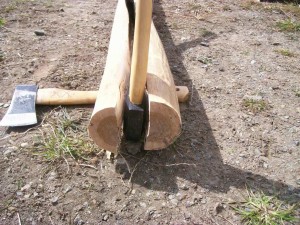This was a great informative article, and I’d like to share the info. Like the author, I am neither a professional bowyer nor an amazing archer; but I have always been fascinated with traditional long bows, especially the English/war bow, such as those recovered from the ship wreck of the Mary rose. My brothers and I have made many bows but they tend to break because we’ve gotten over ambitious with the draw weight of different kinds of woods. Any wood can be used for a bow; but you need to know the limitations. I did make some great little red oak long bows for my children last Christmas the shoot like a charm, but once again, they have a very low poundage draw. So here is some great database information and the main article found at http://www.wood-database.com/wood-articles/bow-woods/, and http://www.wood-database.com/. One element crucial to bowyers that is not part of the article is the necessity to involve both heart and sap wood for convention single stave long bows. the complete database, with a little math, will give you a great idea of what families of trees to avoid and what families offer good general characteristics. Enjoy.
Jon
by Eric Meier
Disclaimer: I am neither a bowyer/archer nor a materials scientist/engineer. The data and ideas presented in this article are by no means meant to be considered authoritative or precisely correlated to real-world situations. The purpose of the article is simply to foster imagination and exploration in the area of bow woods and what does/does not constitute a good bow wood.
Archery bows present a somewhat unique challenge in finding the right requirements for the best wood. In the simplest and crudest terms possible, the wood should be able to bend, but not break. With all of the data available on the Wood Database, there’s no single measurement that directly indicates a wood’s ability to bend easily without breaking. Instead, it is primarily a combination of two values: the wood’s modulus of elasticity (also known as MOE), and the modulus of rupture (also known as MOR).
Again, dealing in the simplest terms:
1.The modulus of elasticity (MOE) measures how easily a wood will bend, (the higher the number, the more stubborn and stiff it will be).
2.The modulus of rupture (MOR) measures how easily the wood will break, (the higher the numer, the harder it is to break or rupture).
In terms of looking at the raw mechanical data of woods, the best bow woods tend to be those that have a low MOE and a high MOR. (Stated another way, the best bow woods tend to be those that will bend easily, and not break.) It’s of little advantage if a given wood scores well in one area, and poorly in another (i.e., a very low MOE or a very high MOR). What is most important, regardless of how low the MOE may be, or how high the MOR may be, is the ratio of the MOE to the MOR; it must be easy to bend AND hard to break.
Given the rationale and requirements, an equation can be formed to roughly assess a wood’s suitability for bow use: (MOR/MOE) * 1000. (The added factor of 1000 is simply to bring the number to a more manageable size and avoid dealing with tiny .00xx decimal values.) For lack of a better term, this ratio will simply be referred to as the wood’s “Bow Index.”
Analyzing all the woods in the Wood Database for their Bow Index, the following results are obtained:
The Highest Bow Index:
Madagascar Rosewood, 13.76, Data is taken from a several species in the Dalbergia genus, (D. baronii, D. greveana, D. madagascariensis, and D. monticola), so it may not reflect an accurate picture of any one particular species of the grouping that is referred to as “Madagascar Rosewood.”
Muninga, 11.81, Along with Madagascar Rosewood, Muninga represents another curiosity. On paper, it appears to rank right alongside other historically proven bow woods such as Yew and Osage Orange. Real-world results may differ.
European Yew, 11.52, No MOE data could be located for European Yew (Taxus baccata), but the values for Pacific Yew (Taxus brevifolia) are so close to identical that they have been carried over and used for the European species. A slightly higher MOR puts European Yew ahead of Pacific Yew by a nose, though from a numerical standpoint they should be considered equivalent.
Osage Orange, 11.51, Given the great differences in density and overall strength between Yew and Osage Orange, it’s very interesting to note that the Bow Index of the two species comes out to nearly the same. Note that this is for the North American species, with Argentine Osage Orange only scoring an above-average Bow Index of 9.06.
Pacific Yew 11.26
Guajayvi, 10.90, Good luck finding this wood.
Tambootie 10.90
Chinaberry 10.85
Pear 10.68
Cebil 10.61
Mansonia 10.57
Turkey Oak 10.57
Makore 10.55
Movingui 10.52
Field Maple 10.42
English Walnut 10.31
Alligator Juniper 10.31
Brazilwood 10.22
The Lowest Bow Index:
Jelutong 6.56
White Fir 6.53
Tatajuba 6.52
Norway Spruce 6.49
Sumatran Pine 6.49
Yellow Buckeye 6.41
Yellow Poplar 6.39
Subalpine Fir 6.36
Bigtooth Aspen 6.36
Balsam Fir 6.35
Sitka Spruce 6.34
Eastern Cottonwood 6.20
Balsam Poplar 6.18
Pacific Silver Fir 6.09
Austrian Pine 5.96
Basswood 5.96
Balsa 5.73
Grand Fir 5.71
To look up all types of woods follow the links above. They are categorized alphabetically and are full of pertinent information relevant to a bowyer and general species information.


Leave a Reply